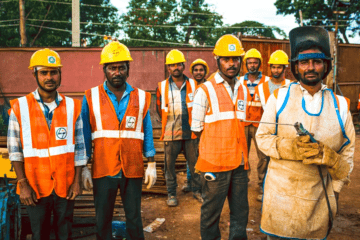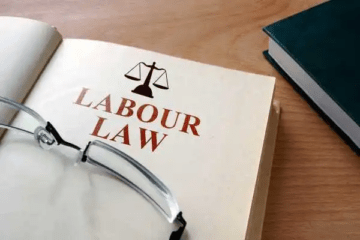
This article is written by Namrata Dube of 9th Semester of B.A.LL.B. of South Calcutta Law College, Kolkata, an intern under Legal Vidhiya.
Abstract: –
The general meaning of the word “strike” is that, when the workers discontinue working because of an argument with their employer regarding the working conditions, job loses or pay levels etc. On the other hand, the word “lock-out” means when the employer temporarily closes the place of work or suspends the work, until the employees agree to the conditions laid down by the employer. Basically, lock-out is the reverse of strike. The aim of this article is to provide a basic understating of the terms “strike” and “lock-out”. Besides this article also deals with the significant case laws, ingredients and types of strikes and lock outs.
Keywords: – Industrial Disputes Act, employers, employees, deadlock, suspension, pen-down strike, Fundamental Right, Statutory Right, coercion, violence.
Introduction: –
The strike is an essential instrument of the collective bargaining process. It is a well-recognised tool available to the workers, which help them to negotiate with the employer, so that he agrees upon their demand. Lock-out is also another vital tool for the employer. It is in the hand of the employer, by which he can compel the workers to further negotiate on their conditions (in the favour of the employer).
Strike is a part of negotiating tool, with the help of this weapon, the workers can bargain about their pay and their better working conditions. In absence of this right of strike, there will be imbalance of power between the workers and the employers. But sometimes, it happens that the workers conditions and demands puts pressure on the employers. Thus, to break the deadlock in negotiation the employers use this weapon. Thus, both of the instruments of the employers and of the workers i.e., lock-out and strike respectively are significant and justifiable.
Strike: –
Meaning-
A strike is a collective suspension of work, which is agreed upon and carried out by a number of workers for the purpose of remedying a grievance. It is an essential tool which help the workers to bargain with the employer, so that he agrees upon their demand. It gained popularity during the Industrial Revolution, when mass workers necessary in mines and factories. But it was made illegal as the employers had more power than the workers.
The most significant ingredients of strikes are that, it must be in an establishment which falls under the definition of “industry” as mentioned in Sec. 2 (j) of the Industrial Disputes Act,1947. Also there should be a relationship (employer and employee) between the employer and the striking workmen. Besides, there should be suspension of work by the workers.
Types: –
There are various kinds of strikes, they are enumerated below: –
- General Strike- In this type of strike the workers for a common reason or demand, all together refuses to work, depriving the employer of his employees to carry on his business.
- Token Strike- It is generally the before stage of the general strike. This kind of strike is normally of shorter period for example, for an hour or two. The main objective of this kind of strike is to draw the attention of the management towards their demand by showing cooperation among them.
- Sit-down Strike- In this type of strike where the workers will leave the workplace, but will not agree to do their work or to leave the workplace.
- Pen-down Strike- In this type of strike the workmen report to their duties, occupy the premises but do not work.
- Economic Strike- In this type of strike a strike is called in protest over wages, working conditions and hours. For example, a strike in the protest for the health benefits.
- Sympathy Strike- In this kind of strike a protest is done in support of other workers who are on strike.
- Wildcat Strike- In this kind of strike, there is stoppage of work undertaken by employees without the consent of their respective unions.
- Go-slow Strike- In this kind of strike, a protest is done by workers in which they deliberately work slowly in order to cause problems for their employers.
- Sick out Strike- It is a type of strike where a joint action by a group of employees claiming illness and not reporting for work in order to force the granting of certain demands.
Justification: –
The most significant purpose of strike is to keep a balance of power between the employer and the worker. Generally, the employer possesses more power than the employee. So, it becomes difficult for the employee to make a stand. But strike (a last resort) is the only tool for them to protect themselves. It helps the workers to avoid being at the mercy of their employers. In absence of strike action, the industries and corporations will be able to make bigger profits, while the working conditions of the workers will get deteriorated. Thus, strike is considered to be significant. A strike is justifiable if it was called for a serious issue or it had enough potential to affect the conditions of the workers. However, during a strike if coercion or violence is used, it will nullify whatever justification a strike may have.
Case Laws: –
In the case of Cropton Greaves Ltd. v. Workmen, (AIR 1978 SC 1489) it was observed that in order to entitle the workmen to wages for the period of strike, the strike should be legal and justified, which does not violate any provision of the statute.
In the case of T.K. Rangarajan v. Government of Tamil Nadu, (2003) 6 SCC 581, it was observed that the right to strike is neither a fundamental right nor a legal or statutory right. The similar verdict was given in the case of B.R. Singh v. Union of India.
In the case of Punjab National Bank v. All India Punjab National Bank Employees’ Federation, (1953 AIR 296) it was observed that a pen-down strike can be considered as a strike. It is so because in this kind of strike, the worker enters the office or premises of work but do not agree to work.
In the case of Moti Lal Yadav v. State of UP,2019, it as held that the doctors do not have the right to deny medical treatment, on the ground that they are strike.
Lock-out: –
Meaning-
As like strike, lock-out is also the stoppage of work, but in this an employer obstructs the workers from working. Thus, a lock-out is employers’ weapon, where he temporarily closes or suspends the work in the place of employment and refuses to employ any number of employees. When an uncontrollable situation arises in the company, no matter how much loss it will cause to both the employer and the employees, a lock-out is the ultimate tool left in the hands of the management.
The definition of lock-out consists of three components, they are enumerated below: –
- There will be temporary closing of a place of employment, or
- There will be suspension of work, or
- There will refusal of employment of any number of persons employed by the employer.
Justification: –
A lock-out is important to avoid any industrial dispute, violence or any property damage. It is also important when there re illegal strikes, regular or continuous strikes by the workers. The strikes and lock-out is treated in the same manner. The circumstances in which the legislature had banned strike, it has also banned the lock-out. Thus, what is legal- illegal, justified- unjustified for strike is same for the lock-out. The reason for which the lock-out is banned is the same for which the strike is also banned. This is so because there is no discrimination in the respective rights in the field of industrial relationship between the employer and the employee.
Case Laws: –
In the case of Hal Employees Union v. The Presiding Officer and Anr,1995 it was declared that, the lock-out in this present case is both justified and legal as, the lock out is the result of illegal strike by the workers. The workers in this case are not entitled to the payment of wages for the period during which the lock-out is continued.
In the case of Lord Krishna Saharanpur v. State of UP, (ILR 1973 Delhi 570) it was held that a lock-out may sometimes be not connected with economic demands, it may be used as a security measure.
In the case of Eastern Medikit Ltd v. State of Haryana and others,2014 it was held that since the management has closed the factory which reflects an illegal lock-out, a case of illegal lock-out by the management be recommended as unconstitutional.
Conclusion: –
Thus, it can be concluded that strike and lock-out are legal and justified, if it was called for a serious issue or it had enough potential to affect the conditions of the workers or of the employers. But if coercion or violence is used, it will nullify whatever justification a strike or lock-out may have. A strike and a lock-out are legal if it does not violate any provision of the statute. It can be justified only when the reason for it is reasonable and compliant. Though a declaration of lock-out or strike leads to an environment of instability where workers are left unemployed and the factories or workplaces are temporarily closed (causes loss for both the workers and the employers). But it is much needed to keep the balance of power between the workers and the employers. Therefore, it can be said that the strike and lock-out are effective weapon for both the employers and the employee, provided that such weapons are used lawfully and ethically.
Reference: –
- Industrial Disputes Act,1947 (D.D.Seth, 2022) (10th Edition, 2022)
- (R.Arunkumar, n.d.) Strikes and Lockouts-a Contemporary Analysis, legalserviceindia
- (Manglani, n.d.) How strikes and lockouts considered as weapons of collective bargaining limitations on managerial prerogatives, iPleaders




0 Comments